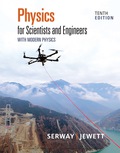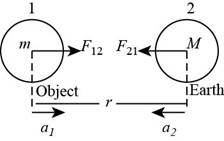
(a)
To determine: The magnitude of the relative acceleration as a function of
(a)
Answer to Problem 41AP
Answer: The magnitude of the relative acceleration as a function of
Explanation of Solution
Explanation:
Given information:
A object of mass

Figure I
Formula to calculate the relative acceleration is,
Formula to calculate the gravitational force exerted by the object on the Earth is,
By Newton’s law the force exerted by the object is,
From equation (II) and equation (III) is,
The forces
Substitute
By Newton’s law the force exerted by the Earth is,
From equation (IV) and equation (V) is,
Substitute
Substitute
Conclusion:
Therefore, the magnitude of the relative acceleration as a function of
(b)
To determine: The magnitude of the relative acceleration for
(b)
Answer to Problem 41AP
Answer: The magnitude of the relative acceleration for
Explanation of Solution
Explanation:
Given information:
A object of mass
From equation (VI) the relative acceleration is,
Substitute
Conclusion:
Therefore, the magnitude of the relative acceleration for
(c)
To determine: The magnitude of the relative acceleration for
(c)
Answer to Problem 41AP
Answer: The magnitude of the relative acceleration for
Explanation of Solution
Explanation:
Given information:
A object of mass
From equation (VI) the relative acceleration is,
Substitute
Conclusion:
Therefore, the magnitude of the relative acceleration for
(d)
To determine: The magnitude of the relative acceleration for
(d)
Answer to Problem 41AP
Answer: The magnitude of the relative acceleration for
Explanation of Solution
Explanation:
Given information:
A object of mass
From equation (VI) the relative acceleration is,
Substitute
Conclusion:
Therefore, the magnitude of the relative acceleration for
(e)
To determine: The pattern of variation of relative acceleration with
(e)
Answer to Problem 41AP
Answer: The relative acceleration is directly proportional to the mass
Explanation of Solution
Explanation:
Given information:
A object of mass
From equation (VI) the relative acceleration is,
This is the linear equation and shows the relative acceleration is directly proportional to the object having mass
Conclusion:
Therefore, the relative acceleration is directly proportional to the object having mass
Want to see more full solutions like this?
Chapter 13 Solutions
Physics for Scientists and Engineers with Modern Physics
- Pls help asaparrow_forward3. If the force of gravity stopped acting on the planets in our solar system, what would happen? a) They would spiral slowly towards the sun. b) They would continue in straight lines tangent to their orbits. c) They would continue to orbit the sun. d) They would fly straight away from the sun. e) They would spiral slowly away from the sun. 4. 1 The free-body diagram of a wagon being pulled along a horizontal surface is best represented by A F N B C 0 Ꭰ FN E a) A b) B c) C app app The app 10 app d) e) ס ח D E 10 apparrow_forwardPls help ASAParrow_forward
- Pls help asaparrow_forwardPls help asaparrow_forwardThe acceleration of an object sliding along a frictionless ramp is inclined at an angle 0 is 9. a) g tano b) g cose c) g sino 10. d) g e) zero A 1.5 kg cart is pulled with a force of 7.3 N at an angle of 40° above the horizontal. If a kinetic friction force of 3.2 N acts against the motion, the cart's acceleration along the horizontal surface will be a) 5.0 m/s² b) 1.6 m/s² c) 2.4 m/s² 11. d) 1.0 m/s² e) 2.7 m/s² What is the net force acting on an object with a mass of 10 kg moving at a constant velocity of 10 m/s [North]? a) 100 N [North] b) 100 N [South] 10 N [North} d) 10 N [South] e) None of these.arrow_forward
- Modified True/False - indicate whether the sentence or statement is true or false. If the statement is false, correct the statement to make it true. 12. An object in uniform circular motion has a constant velocity while experiencing centripetal acceleration. 13. An object travelling in uniform circular motion experiences an outward centrifugal force that tends to pull the object out of the circular path. 14. An object with less inertia can resist changes in motion more than an object with more inertia. 15. For an object sliding on a horizontal surface with a horizontal applied force, the frictional force will always increase as the applied force increases.arrow_forwardPls help asaparrow_forwardAnswer the given question showing step by step by and all necessary working out.arrow_forward
 Principles of Physics: A Calculus-Based TextPhysicsISBN:9781133104261Author:Raymond A. Serway, John W. JewettPublisher:Cengage Learning
Principles of Physics: A Calculus-Based TextPhysicsISBN:9781133104261Author:Raymond A. Serway, John W. JewettPublisher:Cengage Learning Glencoe Physics: Principles and Problems, Student...PhysicsISBN:9780078807213Author:Paul W. ZitzewitzPublisher:Glencoe/McGraw-Hill
Glencoe Physics: Principles and Problems, Student...PhysicsISBN:9780078807213Author:Paul W. ZitzewitzPublisher:Glencoe/McGraw-Hill Classical Dynamics of Particles and SystemsPhysicsISBN:9780534408961Author:Stephen T. Thornton, Jerry B. MarionPublisher:Cengage Learning
Classical Dynamics of Particles and SystemsPhysicsISBN:9780534408961Author:Stephen T. Thornton, Jerry B. MarionPublisher:Cengage Learning University Physics Volume 1PhysicsISBN:9781938168277Author:William Moebs, Samuel J. Ling, Jeff SannyPublisher:OpenStax - Rice University
University Physics Volume 1PhysicsISBN:9781938168277Author:William Moebs, Samuel J. Ling, Jeff SannyPublisher:OpenStax - Rice University Physics for Scientists and Engineers: Foundations...PhysicsISBN:9781133939146Author:Katz, Debora M.Publisher:Cengage Learning
Physics for Scientists and Engineers: Foundations...PhysicsISBN:9781133939146Author:Katz, Debora M.Publisher:Cengage Learning Modern PhysicsPhysicsISBN:9781111794378Author:Raymond A. Serway, Clement J. Moses, Curt A. MoyerPublisher:Cengage Learning
Modern PhysicsPhysicsISBN:9781111794378Author:Raymond A. Serway, Clement J. Moses, Curt A. MoyerPublisher:Cengage Learning





